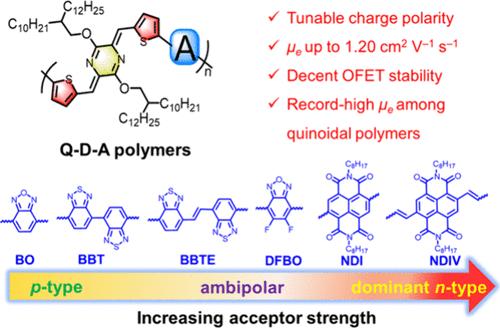基于高性能晶体管受体工程的醌-给体-受体聚合物的电荷极性调制和高效电子输运
IF 5.2
1区 化学
Q1 POLYMER SCIENCE
引用次数: 0
摘要
在共轭聚合物中微调电荷极性和增强电子输运是开发高性能有机场效应晶体管(ofet)的关键。醌类聚合物具有平面骨架和深层最低未占据分子轨道(LUMO)能级的特点,与芳香类聚合物相比具有明显的优势,但在实现超过1 cm2 V-1 s-1的可靠电子迁移率方面面临挑战。在此,我们合成并表征了一组具有不同受体单元的新型quoid - donor -受体(Q-D-A)聚合物。增加受体强度缩小带隙,降低LUMO能级,将电荷极性从单极p型转变为双极性,最终转变为主导的n型行为。电子与空穴的迁移比从0增加到40,并首次在Q-D-A聚合物中观察到电子传递行为。因此,最强的受体基聚合物具有平面骨架,电子有效质量小,结晶度高,无序性低,电子迁移率为1.20 cm2 V-1 s-1,具有良好的操作稳定性。这种迁移率是具有可靠电子传递的quinoidal聚合物的创纪录的高值。我们的研究结果为调整电荷极性和改善quinoidal聚合物中的n型输运提供了一种可行的策略,为推进高性能有机电子学所必需的结构-性能关系提供了见解。本文章由计算机程序翻译,如有差异,请以英文原文为准。

Charge Polarity Modulation and Efficient Electron Transport in Quinoid–Donor–Acceptor Polymers by Acceptor Engineering for High-Performance Transistors
Fine-tuning the charge polarity and enhancing electron transport in conjugated polymers are critical for developing high-performance organic field-effect transistors (OFETs). Quinoidal polymers, characterized by planar backbones and deep-lying lowest unoccupied molecular orbital (LUMO) energy levels, offer distinct advantages over their aromatic counterparts but face challenges in achieving reliable electron mobilities exceeding 1 cm2 V–1 s–1. Herein, we synthesized and characterized a set of novel quinoid–donor–acceptor (Q-D-A) polymers with various acceptor units. Increasing acceptor strength narrowed the band gap, lowered LUMO levels, and shifted charge polarity from unipolar p-type to ambipolar and ultimately to dominant n-type behavior. The electron-to-hole mobility ratio increased from 0 to 40 with electron transport behavior observed in a Q-D-A polymer for the first time. Consequently, the strongest acceptor-based polymer exhibited a planar backbone, small electron effective mass, high crystallinity, and low disorder, resulting in a reliable electron mobility of 1.20 cm2 V–1 s–1 with decent operational stability. This mobility is a record-high value for quinoidal polymers with reliable electron transport. Our findings offer a viable strategy for tuning charge polarity and improving n-type transport in quinoidal polymers, providing insights into the structure–property relationships essential for advancing high-performance organic electronics.
求助全文
通过发布文献求助,成功后即可免费获取论文全文。
去求助
来源期刊

Macromolecules
工程技术-高分子科学
CiteScore
9.30
自引率
16.40%
发文量
942
审稿时长
2 months
期刊介绍:
Macromolecules publishes original, fundamental, and impactful research on all aspects of polymer science. Topics of interest include synthesis (e.g., controlled polymerizations, polymerization catalysis, post polymerization modification, new monomer structures and polymer architectures, and polymerization mechanisms/kinetics analysis); phase behavior, thermodynamics, dynamic, and ordering/disordering phenomena (e.g., self-assembly, gelation, crystallization, solution/melt/solid-state characteristics); structure and properties (e.g., mechanical and rheological properties, surface/interfacial characteristics, electronic and transport properties); new state of the art characterization (e.g., spectroscopy, scattering, microscopy, rheology), simulation (e.g., Monte Carlo, molecular dynamics, multi-scale/coarse-grained modeling), and theoretical methods. Renewable/sustainable polymers, polymer networks, responsive polymers, electro-, magneto- and opto-active macromolecules, inorganic polymers, charge-transporting polymers (ion-containing, semiconducting, and conducting), nanostructured polymers, and polymer composites are also of interest. Typical papers published in Macromolecules showcase important and innovative concepts, experimental methods/observations, and theoretical/computational approaches that demonstrate a fundamental advance in the understanding of polymers.
 求助内容:
求助内容: 应助结果提醒方式:
应助结果提醒方式:


